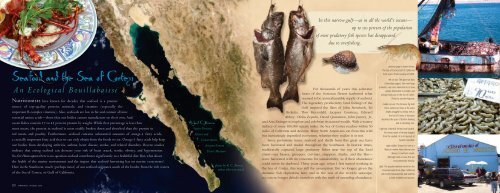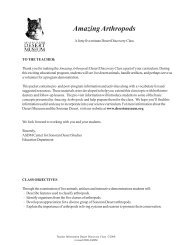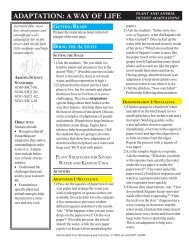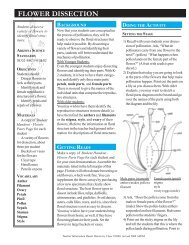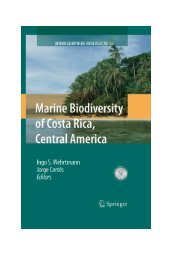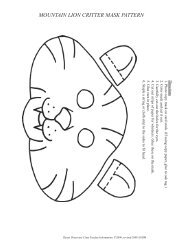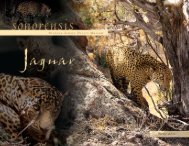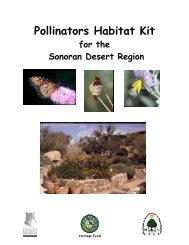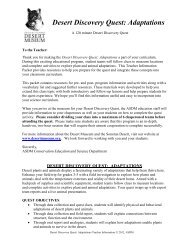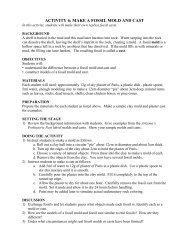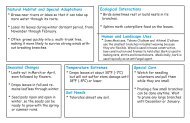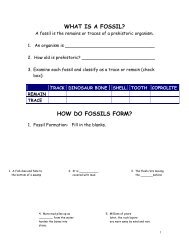Seafood and the Sea of Cortez - Arizona-Sonora Desert Museum
Seafood and the Sea of Cortez - Arizona-Sonora Desert Museum
Seafood and the Sea of Cortez - Arizona-Sonora Desert Museum
You also want an ePaper? Increase the reach of your titles
YUMPU automatically turns print PDFs into web optimized ePapers that Google loves.
In this narrow gulf—as in all <strong>the</strong> world’s oceans—<br />
up to 90 percent <strong>of</strong> <strong>the</strong> population<br />
<strong>of</strong> most predatory fish species has disappeared<br />
due to overfishing.<br />
previous page: Lobster dinner;<br />
The <strong>Sea</strong> <strong>of</strong> <strong>Cortez</strong> (Gulf <strong>of</strong> California)<br />
from space. Photo courtesy <strong>of</strong> NASA.<br />
left cut-out: The giant sea bass<br />
(Stereolepis gigas), like most large<br />
predators, was once abundant but is now<br />
greatly diminished in number <strong>and</strong><br />
average body size in <strong>the</strong> <strong>Sea</strong> <strong>of</strong> <strong>Cortez</strong>.<br />
Photo by Jennifer Rupnow.<br />
An Ecological Bouillabaisse<br />
Nutritionists have known for decades that seafood is a premier<br />
source <strong>of</strong> top-quality protein, minerals, <strong>and</strong> vitamins (especially <strong>the</strong><br />
important B-complex vitamins). Also, seafoods are low in fat <strong>and</strong> contain all nine<br />
essential amino acids—those that our bodies cannot manufacture on <strong>the</strong>ir own. And,<br />
ocean fishes contain 17 to 25 percent protein by weight. While that percentage is less than<br />
most meats, <strong>the</strong> protein in seafood is more readily broken down <strong>and</strong> absorbed than <strong>the</strong> protein in<br />
red meats <strong>and</strong> poultry. Fur<strong>the</strong>rmore, seafood contains substantial amounts <strong>of</strong> omega-3 fatty acids,<br />
a crucially important fatty acid that we can only obtain from <strong>the</strong> foods we eat. Omega-3 fatty acids help keep<br />
our bodies from developing arthritis, asthma, heart disease, stroke, <strong>and</strong> related disorders. Recent studies<br />
indicate that eating seafood can decrease your risk <strong>of</strong> heart attack, stroke, obesity, <strong>and</strong> hypertension.<br />
So, for Homo sapiens <strong>the</strong>re is no question seafood contributes significantly to a healthful diet. But, what about<br />
<strong>the</strong> health <strong>of</strong> <strong>the</strong> marine environment <strong>and</strong> <strong>the</strong> impact that seafood harvesting has on marine ecosystems<br />
Here in <strong>the</strong> Southwest, much (perhaps most) <strong>of</strong> our seafood originates south <strong>of</strong> <strong>the</strong> border, from <strong>the</strong> rich waters<br />
<strong>of</strong> <strong>the</strong> <strong>Sea</strong> <strong>of</strong> <strong>Cortez</strong>, or Gulf <strong>of</strong> California.<br />
Richard C. Brusca,<br />
Senior Director,<br />
Science <strong>and</strong><br />
Conservation,<br />
<strong>Arizona</strong>-<strong>Sonora</strong><br />
<strong>Desert</strong> <strong>Museum</strong><br />
photos by R. C. Brusca,<br />
unless o<strong>the</strong>rwise noted<br />
For thous<strong>and</strong>s <strong>of</strong> years this saltwater<br />
heart <strong>of</strong> <strong>the</strong> <strong>Sonora</strong>n <strong>Desert</strong> harbored what<br />
seemed to be an inexhaustible supply <strong>of</strong> seafood.<br />
The legendary productivity (<strong>and</strong> fishing) <strong>of</strong> <strong>the</strong><br />
Gulf inspired <strong>the</strong> likes <strong>of</strong> John Steinbeck, Ed<br />
Ricketts, Thor Heyerdahl, Jacques Cousteau, Edward<br />
Abbey, Ofelia Zepeda, David Quammen, John Janovy, Jr.,<br />
<strong>and</strong> Ann Zwinger to explore <strong>and</strong> celebrate its natural wealth. With a watery<br />
surface <strong>of</strong> some 100,000 square miles, <strong>the</strong> <strong>Sea</strong> <strong>of</strong> <strong>Cortez</strong> reaches within 50<br />
miles <strong>of</strong> California <strong>and</strong> <strong>Arizona</strong>. Many North Americans eat from this wild<br />
but increasingly imperiled ecosystem, whe<strong>the</strong>r <strong>the</strong>y realize it or not.<br />
Since prehistoric times, seafood <strong>and</strong> shells from this great sea have<br />
been harvested <strong>and</strong> traded throughout <strong>the</strong> Southwest. In historic times,<br />
traditionally captured large predatory fishes near <strong>the</strong> top <strong>of</strong> <strong>the</strong> food<br />
chain—sea basses, groupers, corvinas, snappers, sharks, <strong>and</strong> <strong>the</strong> like—<br />
were harvested with no concerns for sustainability, as if <strong>the</strong>ir abundance<br />
could never be depleted. Thirty years ago, when I first started working in<br />
<strong>the</strong> <strong>Sea</strong> <strong>of</strong> <strong>Cortez</strong>, this was still <strong>the</strong> assumption. But no longer; given <strong>the</strong><br />
dramatic fish depletions here <strong>and</strong> in <strong>the</strong> rest <strong>of</strong> <strong>the</strong> world’s seascape,<br />
we can no longer delude ourselves with <strong>the</strong> myth <strong>of</strong> unending abundance.<br />
middle cut-out: The Panamic fig shell<br />
(Ficus ventricosa) lives at <strong>the</strong> same<br />
depths dragged by shrimp nets in<br />
<strong>the</strong> <strong>Sea</strong> <strong>of</strong> <strong>Cortez</strong>; it has been<br />
decimated by years <strong>of</strong> bottom trawling<br />
<strong>and</strong> is becoming rare.<br />
right top: Industrial shrimp boat bycatch.<br />
For every pound <strong>of</strong> shrimp dragged<br />
from <strong>the</strong> seabed, 10 to 40 pounds <strong>of</strong><br />
bycatch are killed.<br />
right middle: Shrimp for sale in a<br />
Mexican market. Most shrimp from<br />
Mexico is now farm raised,<br />
although rarely in ways that are<br />
environmentally friendly.<br />
right: The popular seafood market on <strong>the</strong><br />
Ensenada waterfront (Baja California)<br />
sells locally harvested fish <strong>and</strong> shellfish<br />
to both residents <strong>and</strong> tourists.<br />
20 sonorensis | winter 2009<br />
sonorensis | winter 2009 21
22 sonorensis | winter 2009<br />
above: Pre-Hispanic shell<br />
middens (dining<br />
refuse sites) can be<br />
found near virtually<br />
every coastal wetl<strong>and</strong><br />
in <strong>Sonora</strong>.<br />
Frilled venus clams<br />
(Chione undatella) <strong>and</strong> Panamic<br />
cockles (Trachicardium panamense) for sale<br />
today on <strong>the</strong> malecón at Kino Bay.<br />
Archeological excavations indicate <strong>the</strong>se<br />
species were also popular with Native<br />
American inhabitants along <strong>the</strong> <strong>Sea</strong> <strong>of</strong> <strong>Cortez</strong>.<br />
As a result <strong>of</strong> over-fishing, populations <strong>of</strong><br />
large predators are now a mere shadow<br />
<strong>of</strong> what <strong>the</strong>y were 40 years ago.<br />
In this narrow gulf—as in all <strong>the</strong> world’s oceans—up to 90 percent <strong>of</strong> <strong>the</strong><br />
population <strong>of</strong> most predatory fish species has disappeared due to overfishing.<br />
Today, all <strong>of</strong> <strong>the</strong> traditionally fished species from <strong>the</strong> <strong>Sea</strong> <strong>of</strong> <strong>Cortez</strong> have been<br />
overharvested to <strong>the</strong> point <strong>of</strong> collapse, or near-collapse, <strong>of</strong> <strong>the</strong>ir commercial<br />
fisheries. Traditionally preferred finfish have been so reduced in numbers that<br />
many Mexican fishers now take virtually any fish <strong>the</strong>y can catch, <strong>of</strong> any edible<br />
size. Decades <strong>of</strong> shrimp extraction have not only decimated shrimp populations,<br />
but also severely disrupted <strong>the</strong> seafloor ecosystem in much <strong>of</strong> <strong>the</strong> Gulf.<br />
In <strong>the</strong> nor<strong>the</strong>rn Gulf, <strong>the</strong> commercial finfish <strong>and</strong> wild-shrimp fisheries have<br />
essentially collapsed, <strong>and</strong> tourists in beach towns like Puerto Peñasco (Rocky<br />
Point) are now just as likely to be served cod or pollock, shipped frozen from<br />
Alaska or Europe, as a fresh local fish. Species once regarded as “trash fish” or<br />
“bycatch”—such as triggerfish, parrotfish, <strong>and</strong> skate—are now routinely sold in<br />
<strong>and</strong> restaurants. How did we get here <strong>and</strong> what can we do about it<br />
Ancient harvests from <strong>the</strong><br />
What were early inhabitants <strong>of</strong> <strong>the</strong> Gulf’s desert coastlines consuming, <strong>and</strong><br />
are those edible species still abundant Archeological excavations <strong>of</strong> prehistoric<br />
kitchen middens (dining-site trash dumps) indicate <strong>the</strong>y were feeding<br />
on shellfish, finfish, crabs, <strong>and</strong> sea turtles from coastal lagoons <strong>and</strong> <strong>the</strong> open<br />
coast, although <strong>the</strong>y also captured some terrestrial reptiles, mammals, <strong>and</strong><br />
birds that lived along <strong>the</strong> coast. They relied most heavily on clams <strong>and</strong> blue<br />
crabs, <strong>and</strong> a few fish species taken from coastal lagoons <strong>and</strong> estuaries. Thus,<br />
many <strong>of</strong> <strong>the</strong> seafood traditions that began in <strong>the</strong> <strong>Sea</strong> <strong>of</strong> <strong>Cortez</strong> in prehistoric<br />
time continue to this day in western Mexico, while o<strong>the</strong>rs, such as <strong>the</strong> ritual<br />
harvest <strong>of</strong> sea turtles, have all but disappeared as <strong>the</strong> animals <strong>the</strong>mselves<br />
have dramatically declined over <strong>the</strong> last century.<br />
above: Artisanal (panga) fishers on <strong>the</strong> coast <strong>of</strong> <strong>Sonora</strong>.<br />
cut-out: The Eastern Pacific pearl oyster (Pteria sterna) is <strong>the</strong> first species to be<br />
over-exploited in <strong>the</strong> <strong>Sea</strong> <strong>of</strong> <strong>Cortez</strong>, by Spanish colonists in search <strong>of</strong> pearls.<br />
The Ecological Depletion <strong>of</strong> <strong>the</strong><br />
levels <strong>the</strong> seafloor—<br />
<strong>the</strong> undersea equivalent<br />
<strong>of</strong> clear-cutting forests.<br />
Most wild shrimp are captured by<br />
bottom trawling, “dragging”<br />
with heavy equipment that<br />
above: The jumbo squid (Dosidicus gigas) is thought to have<br />
become abundant in <strong>the</strong> <strong>Sea</strong> <strong>of</strong> <strong>Cortez</strong> as top-predator finfish<br />
have been decimated by over-fishing—<strong>the</strong> squids are presumably<br />
moving in to fill <strong>the</strong> “empty niche.” Photo by A. Kerstitch<br />
right: Long-lines are one <strong>of</strong> <strong>the</strong> most destructive <strong>and</strong> indiscriminant fishing devices ever developed. They kill sea birds,<br />
marine mammals, <strong>and</strong> marine turtles, as well as having a high fish bycatch.<br />
Primary producers, algae <strong>and</strong> seaweeds that capture <strong>the</strong> sun’s energy<br />
at <strong>the</strong> base <strong>of</strong> marine food webs, are especially abundant in this semienclosed<br />
sea. This high primary productivity is driven by year-round<br />
strong solar input, upwelling <strong>of</strong> nutrient-rich bottom waters continuously<br />
drawn into <strong>the</strong> Gulf from <strong>the</strong> open Pacific, <strong>and</strong> good circulation.<br />
And, this productivity has supported one <strong>of</strong> <strong>the</strong> world’s most important<br />
concentrations <strong>of</strong> small oceanic fishes (such as anchovies, sardines,<br />
<strong>and</strong> mackerels), which in turn has provided critically important food<br />
sources for larger predatory fishes, jumbo squid, sea birds, marine<br />
mammals, <strong>and</strong>, eventually, humans. Beginning in <strong>the</strong> 1930s, however,<br />
a strong commercial fishery developed in this rich marine ecosystem,<br />
with some regrettable ecological impacts.<br />
Remember John Steinbeck’s little gem <strong>of</strong> a novel, The Pearl The<br />
first fishery in <strong>the</strong> <strong>Sea</strong> <strong>of</strong> <strong>Cortez</strong> to be over-fished was <strong>the</strong> pearl oyster<br />
fishery <strong>of</strong> <strong>the</strong> La Paz-Cape Region, which drew Spanish colonists to <strong>the</strong><br />
area in <strong>the</strong> 1600s <strong>and</strong> 1700s. Today, every commercial species in <strong>the</strong><br />
Gulf is probably overfished, except perhaps jumbo squid, which only<br />
recently arrived in <strong>the</strong> Gulf <strong>of</strong> California in numbers large enough to<br />
harvest. Artisanal fishers today take about 80 species <strong>of</strong> finfish <strong>and</strong><br />
shellfish, using long-lines, gillnets, cast nets, hook-<strong>and</strong>-line, pots, <strong>and</strong><br />
traps. An estimated 50,000 artisanal fishers operate 25,000 pangas in<br />
<strong>the</strong> Gulf today. And, ano<strong>the</strong>r 10,000 fishers work on some 1,280 industrial<br />
boats. Gulf waters are also subjected to fishing pressure from<br />
sportfishing by American tourists.<br />
Today, <strong>the</strong> most important species for artisanal fishers are shrimp,<br />
jumbo squid, <strong>and</strong> clams. For <strong>the</strong> industrial fishery, <strong>the</strong> Pacific (or Monterey)<br />
sardine is <strong>the</strong> most important species, followed by shrimp, tuna, <strong>and</strong> squid.<br />
As traditionally sought large predatory fish <strong>and</strong> shrimp have dwindled,<br />
industrial fishers have shifted increasingly to sardines <strong>and</strong> jumbo squid.<br />
The shift in primary target species has had significant socioeconomic<br />
impacts, but it could have even more pr<strong>of</strong>ound ecological repercussions.<br />
Sardines <strong>and</strong> anchovy, <strong>and</strong> jumbo squid, are key elements <strong>of</strong> <strong>the</strong> Gulf’s<br />
oceanic ecosystem. They represent species very near <strong>the</strong> bottom <strong>and</strong> top<br />
<strong>of</strong> <strong>the</strong> oceanic food chain, respectively. Their population sizes have direct<br />
effects on <strong>the</strong> rest <strong>of</strong> <strong>the</strong> food web, including <strong>the</strong> reproductive success <strong>of</strong><br />
seabirds. There is a real danger that <strong>the</strong>ir over-exploitation could result<br />
in fundamental changes in <strong>the</strong> oceanic ecosystem.<br />
sonorensis | winter 2009 23
More than one-third <strong>of</strong> <strong>the</strong> seafood<br />
consumed in <strong>the</strong> world<br />
is now farm raised.<br />
cut-out: The increasingly rare regal murex<br />
(Chicoreus regius) is a large, beautiful snail<br />
consumed locally in <strong>the</strong> Gulf. This species is<br />
<strong>of</strong>ten brought up in shrimp trawls <strong>and</strong> o<strong>the</strong>r<br />
bottom nets; <strong>the</strong> shells end up in curio shops.<br />
right: Gill net from a panga fisher,<br />
with bycatch <strong>of</strong> snails <strong>and</strong> crabs.<br />
Unsustainable fishing,<br />
bottom trawling, <strong>and</strong> environmentally<br />
unfriendly<br />
shrimp farming are perhaps<br />
<strong>the</strong> most serious<br />
threats to <strong>the</strong> ecological integrity <strong>of</strong> <strong>the</strong> <strong>Sea</strong> <strong>of</strong> <strong>Cortez</strong> today. As a result <strong>of</strong><br />
over-fishing, populations <strong>of</strong> large predators are now a mere shadow <strong>of</strong><br />
what <strong>the</strong>y were 40 years ago. The devastated populations include sea<br />
basses <strong>and</strong> groupers, sharks, some snappers, <strong>and</strong> even some jacks. Due<br />
to overfishing, some spawning aggregations <strong>of</strong> <strong>the</strong>se <strong>and</strong> o<strong>the</strong>rs large<br />
species—especially <strong>the</strong> goliath grouper <strong>and</strong> giant sea bass—may have<br />
entirely disappeared from <strong>the</strong> Gulf.<br />
Many less visible invertebrate species, also once-abundant, are also<br />
now rare here. Most wild shrimp are captured by bottom trawling, “dragging”<br />
with heavy equipment that levels <strong>the</strong> seafloor—<strong>the</strong> undersea equivalent<br />
<strong>of</strong> clear-cutting forests. The heavy chains on traditional trawl nets dig<br />
15 to 30 centimeters into <strong>the</strong> seabed. For every kilogram <strong>of</strong> wild shrimp<br />
trawled, 10 to 40 kilos <strong>of</strong> additional bycatch is killed! Shrimp trawlers produce<br />
an inordinate percentage <strong>of</strong> <strong>the</strong> global bycatch—capturing less than<br />
two percent <strong>of</strong> <strong>the</strong> world’s seafood by weight, but one-third <strong>of</strong> <strong>the</strong> world’s<br />
bycatch. Worldwide, every year an estimated 150,000 endangered sea turtles<br />
are caught <strong>and</strong> dragged in shrimp nets until <strong>the</strong>y drown. Shrimp<br />
trawlers kill more sea turtles than all o<strong>the</strong>r causes combined.<br />
Richard C. Brusca, Ph.D.<br />
Senior Director, Science<br />
<strong>and</strong> Conservation,<br />
<strong>Arizona</strong>-<strong>Sonora</strong><br />
<strong>Desert</strong> <strong>Museum</strong><br />
Almost everyone loves shrimp, <strong>and</strong> almost every restaurant has at least one shrimp dish<br />
on <strong>the</strong>ir menu. But, <strong>the</strong> large shrimps typically marketed as “jumbo shrimp,” “Gulf shrimp,”<br />
or “Guaymas shrimp” are some <strong>of</strong> <strong>the</strong> most unsustainably harvested seafoods in <strong>the</strong><br />
world. So, what is a shrimp-loving consumer to do Well, here’s <strong>the</strong> deal.<br />
First <strong>of</strong> all, shrimp come in two varieties. The big boys (“jumbo shrimp”) belong<br />
to a group known as <strong>the</strong> penaeid shrimps–technically, <strong>the</strong> Dendrobranchiata. The smaller<br />
shrimps, an inch or less in length <strong>and</strong> usually marketed as “bay shrimp,” “rock<br />
shrimp,” “nor<strong>the</strong>rn shrimp,” or “salad shrimp,” belong to a group known as <strong>the</strong><br />
caridean shrimps (technically, <strong>the</strong> Caridea). They are all crustaceans, but <strong>the</strong> two<br />
groups are only distantly related.<br />
No need to worry about <strong>the</strong> small shrimp; <strong>the</strong>y are by <strong>and</strong> large sustainably harvested.<br />
But jumbo shrimp is ano<strong>the</strong>r story altoge<strong>the</strong>r. Traditionally, <strong>the</strong>y are trawled from <strong>the</strong><br />
seabed with gigantic nets—a process that literally destroys <strong>the</strong> seabed <strong>and</strong> all <strong>the</strong> life that<br />
lives <strong>the</strong>re. Bottom trawling for shrimp is <strong>the</strong> most destructive fishing practice on Earth. In<br />
<strong>the</strong> United States <strong>the</strong>re are regulations that require shrimp fishers to use better designs <strong>of</strong><br />
bottom trawls, so <strong>the</strong> damage from U.S. trawlers is somewhat less than seen in most <strong>of</strong> <strong>the</strong><br />
rest <strong>of</strong> <strong>the</strong> world. Even so, <strong>the</strong>y still cause an unacceptable level <strong>of</strong> seafloor damage. One<br />
fishing operation in <strong>the</strong> <strong>Sea</strong> <strong>of</strong> <strong>Cortez</strong> (Pesquera Delly), has been trying to lead <strong>the</strong> way in<br />
Mexico by using <strong>the</strong>se less-destructive net designs; however, <strong>the</strong> future <strong>of</strong> this effort is<br />
left previous page: Gulf cleaner shrimp (Lysmata californica); above: Shrimp in fish market; Industrial shrimp boat bycatch; Coastal mangrove lagoons are critical nursery habitats for commercial shrimps.<br />
unclear. So, right now, <strong>the</strong> only good choice for wild-caught jumbo shrimp is <strong>the</strong> artisanal shrimp<br />
fishery <strong>of</strong> Mexico’s <strong>Sea</strong> <strong>of</strong> <strong>Cortez</strong>, which uses small boats (pangas) powered with outboard<br />
motors, <strong>and</strong> floating nets ra<strong>the</strong>r than bottom trawls. However, since <strong>the</strong>re is not yet a certification<br />
process that tells consumers <strong>the</strong> origin <strong>of</strong> <strong>the</strong> Mexican shrimp sold in our markets, it is best<br />
to avoid all Mexican shrimp, <strong>and</strong> also all U.S. wild-caught shrimp.<br />
The alternative to wild-caught shrimp is farmed shrimp. Almost all shrimp farming takes<br />
place in ear<strong>the</strong>n lagoons dredged along coastlines in <strong>the</strong> world’s tropics, where environmental<br />
regulations are typically weak or unenforced. Coastal environmental impacts are especially<br />
high in Sou<strong>the</strong>ast Asia, e.g., Thail<strong>and</strong>, Vietnam, <strong>and</strong> Bangladesh. (These are <strong>the</strong> only three<br />
countries <strong>of</strong> origin I saw on a recent frozen-shrimp search at my local Trader Joe’s market!).<br />
Endangered habitats such as mangrove forests are being destroyed or degraded in all <strong>of</strong> <strong>the</strong><br />
tropical countries where shrimp farming is taking place. And, once <strong>the</strong> shrimp ponds are in<br />
place, <strong>the</strong> operations flush directly into <strong>the</strong> sea, polluting it with wastewater, a variety <strong>of</strong> chemicals<br />
(pesticides, antibiotics, powerful disinfectants), escaped exotic shrimp, <strong>and</strong> exotic strains<br />
<strong>of</strong> shrimp diseases that infest local wild populations.<br />
But, <strong>the</strong>re’s good news. U.S. shrimp farmers must adhere to strict regulations that circumvent<br />
most <strong>of</strong> <strong>the</strong> above problems. For example, U.S. shrimp farms are not allowed to drain<br />
directly into <strong>the</strong> sea. And, more <strong>and</strong> more U.S. farms are using largely vegetable-based feeds<br />
that produce shrimp at close to a 1:1 ratio <strong>of</strong> fish-food to shrimp production, as opposed to<br />
fish pellets made from wild-caught fish, requiring a 3:1 ratio (an actual net loss from <strong>the</strong> sea). A<br />
fine example <strong>of</strong> good shrimp farming practices is <strong>the</strong> <strong>Desert</strong> Sweet Shrimp Farm in Gila Bend,<br />
<strong>Arizona</strong> (www.desertsweetshrimp.com). In Mexico, in just <strong>the</strong> past few years, new federal <strong>and</strong><br />
state regulations on shrimp farming have also been improving <strong>the</strong> situation. Some farms are<br />
For now <strong>the</strong> consumer’s best choice for sustainably produced<br />
jumbo shrimp is U.S. farm-raised.<br />
moving inl<strong>and</strong>, away from <strong>the</strong> fragile coastal environment, <strong>and</strong> in <strong>Sonora</strong> <strong>the</strong>se new shrimp<br />
farms <strong>of</strong>ten use l<strong>and</strong> that was long-ago ruined by too many years <strong>of</strong> intensive agriculture—barren<br />
l<strong>and</strong> is thus being recycled <strong>and</strong> put to good use. These inl<strong>and</strong> shrimp ponds still drain to <strong>the</strong><br />
sea, but <strong>the</strong> long canals (up to several kilometers) quickly develop a natural flora <strong>and</strong> fauna <strong>of</strong><br />
<strong>the</strong>ir own that helps to “filter” <strong>the</strong> discharge water before it reaches <strong>the</strong> coast. A good example<br />
<strong>of</strong> <strong>the</strong>se improved practices in Mexico is <strong>the</strong> La Borbolla shrimp farm, south <strong>of</strong> Kino Bay. La<br />
Borbolla has roughly a 1:1 ratio <strong>of</strong> fish-food to shrimp production, <strong>and</strong> can produce 25 to 35<br />
shrimp per square meter <strong>of</strong> pond. In 2008, <strong>the</strong> operation produced over two million pounds<br />
<strong>of</strong> Pacific white shrimp. But, <strong>the</strong>se kinds <strong>of</strong> shrimp farms are still rare in Mexico.<br />
So, for now <strong>the</strong> consumer’s best choice for sustainably produced jumbo shrimp is U.S.<br />
farm-raised. Hopefully, in <strong>the</strong> near future Mexican farmed shrimp will be equally sustainably<br />
produced. Sticking to conscientious choices will be a challenge for shrimp-lovers, but it is one<br />
we must confront.<br />
24 sonorensis | winter 2009 sonorensis | winter 2009 25
Is Aquaculture <strong>the</strong><br />
More than one-third <strong>of</strong> <strong>the</strong> seafood consumed in <strong>the</strong> world is now farm<br />
raised. Aquaculture has <strong>the</strong> potential to relieve pressures on declining wild<br />
seafood populations <strong>and</strong> create waste-free sustainable production—if it is<br />
done right. Unfortunately, this rarely happens, especially in <strong>the</strong> developing<br />
world (where most <strong>of</strong> our farmed seafoods originate). Most <strong>of</strong> <strong>the</strong><br />
world’s saltwater farming (mariculture) actually threatens wild fish stocks<br />
<strong>and</strong> disrupts or destroys natural habitats.<br />
The cultivation <strong>of</strong> carnivorous fish <strong>and</strong> shellfish (e.g., salmon, shrimp)<br />
has traditionally depended on catching wild fish to feed <strong>the</strong>m, <strong>and</strong> <strong>the</strong>se<br />
farms rely on huge quantities <strong>of</strong> wild-caught seafood. It can take over<br />
three kilos <strong>of</strong> wild-caught fish to raise one kilo <strong>of</strong> farmed salmon or<br />
shrimp, resulting in a net loss <strong>of</strong> fish from <strong>the</strong> sea. Today, about a quarter<br />
<strong>of</strong> all seafood caught in <strong>the</strong> wild is converted into fishmeal to feed<br />
farmed fish <strong>and</strong> shrimp.<br />
In addition, farmed fish <strong>and</strong> shrimp, whose place <strong>of</strong> origin is typically<br />
not local, frequently escape into <strong>the</strong> sea, polluting <strong>the</strong> gene pools <strong>of</strong> native<br />
species <strong>and</strong> introducing exotic diseases. For all <strong>the</strong>se reasons, marine<br />
species that are low in <strong>the</strong> food chain <strong>and</strong> subsist on a plant diet (herbivores)<br />
<strong>and</strong> will breed in captivity (e.g., catfish, trout, tilapia), are <strong>the</strong> best<br />
options for aquaculture.<br />
The first commercial shrimp farms in <strong>the</strong> <strong>Sea</strong> <strong>of</strong> <strong>Cortez</strong> were constructed<br />
in coastal <strong>Sonora</strong> in <strong>the</strong> 1980s. As <strong>of</strong> 2007, more than 150 shrimp<br />
farms had been built on <strong>the</strong> <strong>Sonora</strong> shoreline alone, covering an area <strong>of</strong><br />
100,000 hectares. Today, Mexico is <strong>the</strong> second largest producer <strong>of</strong> farmraised<br />
shrimp in <strong>the</strong> Western Hemisphere, but by <strong>the</strong> Mexican government’s<br />
own reckoning a few years ago, few <strong>of</strong> <strong>the</strong> shrimp farms gain high<br />
marks for sustainable practices.<br />
In Mexico, shrimp are typically raised in dirt ponds bulldozed out <strong>of</strong><br />
coastal habitat. Until very recently, <strong>the</strong>se sites were typically placed in or<br />
next to critically important coastal wetl<strong>and</strong>s, threatening habitat <strong>and</strong> rare<br />
or endemic marsh plants. Many <strong>of</strong> <strong>the</strong> Gulf’s mangrove forests <strong>and</strong> tidal<br />
Avoid <strong>the</strong>se seafoods, at least for now. They come from sources that are overfished or<br />
are caught or farmed in ways that harm o<strong>the</strong>r marine life or <strong>the</strong> environment.<br />
Chilean sea bass/toothfish*, corvina, groupers*, king crab (imported),<br />
mahi mahi/dolphinfish (imported), marlin, monkfish, orange roughy*,<br />
red snapper, salmon (farmed, Atlantic), sharks*, shrimp (all wild-caught, all imported),<br />
spiny lobster (Caribbean), swordfish (imported), totoaba,<br />
tuna (all tuna species caught by longline)*, tuna (bluefin, caught by any method)*<br />
* Limited consumption also advised due to concerns about mercury or o<strong>the</strong>r contaminants.<br />
Best Choices: These fish are abundant, well managed,<br />
<strong>and</strong> caught or farmed in environmentally friendly ways.<br />
Arctic char (farmed), barramundi (U.S. farmed), bay scallops (farmed),<br />
catfish (U.S. farmed), clams (farmed), cod (Alaska line caught)*,<br />
crab: dungeness, stone, king, blue (U.S.), flounder <strong>and</strong> sole (Pacific U.S.),<br />
halibut: Pacific, herring: Atlantic/sardines,<br />
lobster (wild-caught from Pacific Baja* <strong>and</strong> Maine), mahi mahi/dolphinfish (U.S.),<br />
mussels (farmed), octopus, oysters, pollock (Alaska wild-caught),<br />
rainbow trout (U.S. farmed), salmon (Alaska wild-caught), shrimp (U.S. farmed), squid,<br />
striped bass (farmed), swordfish (U.S.), tilapia (U.S. farmed),<br />
tuna (pole-caught albacore, bigeye, yellowfin, skipjack), yellowtail (U.S. farmed)<br />
*certified as sustainable to <strong>the</strong> Marine Stewardship Council st<strong>and</strong>ard (msc.org).<br />
marsh ecosystems have been severely damaged due to a variety <strong>of</strong><br />
coastal development, including <strong>the</strong> rapid growth <strong>of</strong> shrimp farms. In<br />
addition to habitat destruction, Mexico’s coastal shrimp farms usually<br />
flush to <strong>the</strong> open sea. In doing so, huge nutrient loads from uneaten<br />
food, shrimp feces, <strong>and</strong> dead shrimp wash out to <strong>the</strong> coast—along with<br />
antibiotics, added vitamins <strong>and</strong> hormones, o<strong>the</strong>r chemicals used in <strong>the</strong><br />
ponds, <strong>and</strong>, <strong>of</strong>ten, introduced (exotic) microorganisms from o<strong>the</strong>r regions<br />
that are imported with <strong>the</strong> shrimp that are introduced into <strong>the</strong> ponds.<br />
Today, U.S.-farmed shrimp is your best choice because it meets strict<br />
government environmental guidelines. Fortunately, <strong>the</strong> situation in<br />
Mexico is now beginning to improve <strong>and</strong> soon, hopefully, Mexican<br />
farm-raised shrimp will be on <strong>the</strong> recommended list. For now, one <strong>of</strong><br />
<strong>the</strong> best places to purchase seafood is your local Wal-Mart. In 2006, <strong>the</strong><br />
company made a pledge to America that <strong>the</strong>ir U.S. stores would sell only<br />
sustainably harvested seafoods, relying heavily on recommendations <strong>of</strong><br />
<strong>the</strong> Marine Stewardship Council <strong>and</strong> Aquaculture Certification Council.<br />
Because Wal-Mart is <strong>the</strong> world’s largest retail seller <strong>of</strong> seafood, this decision<br />
has had a powerful <strong>and</strong> positive impact on global seafood markets.<br />
In addition, <strong>the</strong> Walton Family Foundation provides hundreds <strong>of</strong> millions<br />
<strong>of</strong> dollars annually for marine conservation efforts; <strong>the</strong>y are especially<br />
active in protecting <strong>the</strong> Gulf <strong>of</strong> California.<br />
What it Being<br />
The rise <strong>of</strong> <strong>the</strong> conservation movement in Mexico over <strong>the</strong> past 20<br />
years has led to significant increased pressure on federal agencies, <strong>and</strong><br />
meaningful steps are now being taken to protect <strong>the</strong> <strong>Sea</strong> <strong>of</strong> <strong>Cortez</strong> for<br />
<strong>the</strong> future. Since <strong>the</strong> l<strong>and</strong>mark declaration <strong>of</strong> two biosphere reserves<br />
Consumer power is enormous! In restaurants,<br />
supermarkets, <strong>and</strong> fish markets, ask about <strong>the</strong> source<br />
<strong>of</strong> <strong>the</strong> seafoods you buy; ask if it is farmed or wild-caught<br />
(<strong>and</strong>, if caught, where <strong>and</strong> how it was caught).<br />
far left: Estero Soldado (San Carlos) is one <strong>of</strong> <strong>the</strong> last remaining mangrove wetl<strong>and</strong>s<br />
in <strong>Sonora</strong> that has not felt <strong>the</strong> impacts <strong>of</strong> shrimp farming.<br />
left: Oyster farm at Kino Bay. Most oyster farms in <strong>the</strong> Gulf are small scale,<br />
open water, sustainable operations.<br />
in northwestern Mexico in 1993—<strong>the</strong> Alto Golfo de California y Delta<br />
del Río Colorado, <strong>and</strong> <strong>the</strong> El Pinacate y Gran Desierto de Altar<br />
Biosphere Reserves—hard work <strong>and</strong> steady lobbying has resulted in <strong>the</strong><br />
establishment <strong>of</strong> 15 more protected areas on <strong>the</strong> Baja California peninsula<br />
<strong>and</strong> in <strong>the</strong> <strong>Sea</strong> <strong>of</strong> <strong>Cortez</strong>.<br />
Creating change in fisheries management has been harder. However,<br />
because <strong>of</strong> declining fisheries catches, pressure from environmental organizations,<br />
<strong>the</strong> rise <strong>of</strong> sustainable seafood initiatives, <strong>and</strong> new political leadership,<br />
things are starting to change. There is reason to believe that <strong>the</strong> government<br />
<strong>of</strong> President Felipe Calderón recognizes <strong>the</strong> need for better fisheries<br />
management. Some positive first steps are being taken. New federal<br />
<strong>and</strong> state laws in Mexico are establishing environmental controls over<br />
coastal aquaculture, including shrimp farming. New coastal wetl<strong>and</strong> protections<br />
are forcing shrimp farms inl<strong>and</strong>, away from sensitive coastlines, <strong>and</strong><br />
regulations on <strong>the</strong> import <strong>of</strong> exotic “seed” shrimp <strong>and</strong> on aquaculture pond<br />
discharges are now appearing. One <strong>of</strong> <strong>the</strong> best examples <strong>of</strong> sustainable mariculture<br />
are <strong>the</strong> oyster farms that have sprung up in most <strong>of</strong> <strong>Sonora</strong>’s coastal<br />
lagoons over <strong>the</strong> past 20 years or so; <strong>the</strong>se farms use no additives <strong>and</strong> do<br />
not pollute or negatively impact <strong>the</strong> environment.<br />
26 sonorensis | winter 2009 sonorensis | winter 2009 27
We don’t need to stop eating seafood;<br />
people lived in a balance<br />
with <strong>the</strong> sea for thous<strong>and</strong>s <strong>of</strong> years, until only recently.<br />
top: Floating tuna farms <strong>of</strong>f <strong>the</strong> Pacific coast <strong>of</strong><br />
Baja California.<br />
middle left: <strong><strong>Sea</strong>food</strong> market, Baja California.<br />
What Can<br />
Because we are now aware <strong>of</strong> <strong>the</strong> depletion <strong>of</strong> <strong>the</strong> seas, we have a<br />
greater responsibility, not just for <strong>the</strong> sake <strong>of</strong> <strong>the</strong> marine environment but<br />
also for our own selfish interests, to pay attention to <strong>the</strong> sources <strong>of</strong> our<br />
seafood. And we now have a wealth <strong>of</strong> information about what to buy<br />
<strong>and</strong> what to avoid to help prevent <strong>the</strong> overharvesting <strong>and</strong> degradation <strong>of</strong><br />
<strong>the</strong> <strong>Sea</strong> <strong>of</strong> <strong>Cortez</strong> <strong>and</strong> o<strong>the</strong>r ocean environments.<br />
In restaurants, supermarkets, <strong>and</strong> fish markets, ask about <strong>the</strong> source<br />
<strong>of</strong> <strong>the</strong> seafoods you buy; ask if it is farmed or wild-caught (<strong>and</strong>, if caught,<br />
where <strong>and</strong> how it was caught). As evidenced by <strong>the</strong> history <strong>of</strong> tuna fishing,<br />
consumer power is enormous. Express your interest in sustainably<br />
harvested products, <strong>and</strong> don’t buy finfish <strong>and</strong> shellfish whose populations<br />
are being decimated. The status <strong>of</strong> <strong>the</strong>se fish may change over time,<br />
so keep up-to-date via websites like those at <strong>the</strong> end <strong>of</strong> this article. In <strong>the</strong><br />
meantime, use <strong>the</strong> lists on <strong>the</strong>se pages to guide your purchases. The<br />
Marine Stewardship Council lists supermarkets <strong>and</strong> restaurants worldwide<br />
that carry <strong>the</strong> council’s sustainable certification, as well as sustainable<br />
seafood sources for your business.<br />
middle right: Gulf giant hermit crab (Petrochirus<br />
californiensis).<br />
left: <strong>the</strong> long-beaked common dolphin<br />
(Delphinus capensis) occurs in pods <strong>of</strong> up to<br />
hundreds <strong>of</strong> individuals in <strong>the</strong> <strong>Sea</strong> <strong>of</strong> <strong>Cortez</strong>.<br />
They are frequently killed by drowning in gill<br />
nets that indiscriminately kill anything that gets<br />
trapped in <strong>the</strong>ir mesh.<br />
For more comprehensive coverage<br />
on sustainable seafood choices, visit:<br />
<strong>Arizona</strong>-<strong>Sonora</strong> <strong>Desert</strong> <strong>Museum</strong><br />
(desertmuseum.org/center/seafood.php)<br />
Monterey Bay Aquarium <strong><strong>Sea</strong>food</strong> Watch Program<br />
(mbayaq.org/cr/cr_seafoodwatch)<br />
Marine Stewardship Council: (www.msc.org)<br />
Oceans Alive (oceansalive.org)<br />
<strong><strong>Sea</strong>food</strong> Choices Alliance (seafoodchoices.com)<br />
We don’t need to stop eating seafood; people lived in a balance<br />
with <strong>the</strong> sea for thous<strong>and</strong>s <strong>of</strong> years, until only recently. Fish<br />
from <strong>the</strong> <strong>Sea</strong> <strong>of</strong> <strong>Cortez</strong>, our <strong>Sonora</strong>n <strong>Desert</strong> ocean, remains an<br />
excellent choice for local healthy food. But we need to better manage<br />
our harvests <strong>and</strong> our consumption to prevent catastrophic collapse<br />
<strong>of</strong> marine ecosystems.<br />
A Special<br />
to Sou<strong>the</strong>rn <strong>Arizona</strong><br />
Restaurateurs<br />
Please consider doing what <strong>the</strong> Ironwood Food Service’s restaurants<br />
do at <strong>the</strong> <strong>Desert</strong> <strong>Museum</strong>—make a pledge to serve only sustainable<br />
seafoods. It’s easy. Just dedicate your menu to seafoods<br />
in <strong>the</strong> “best choices” list in this issue <strong>of</strong> sonorensis (or <strong>the</strong> “best<br />
choices” listed by Monterey Bay Aquarium’s <strong><strong>Sea</strong>food</strong> Watch program).<br />
Delicious preparations are easy—think farmed bay scallops,<br />
Alaskan salmon <strong>and</strong> flounder, Pacific halibut, Maine or Baja<br />
lobster, U.S. mahi mahi, U.S. farmed shrimp <strong>and</strong> tilapia, <strong>and</strong> farmed<br />
mussels, oysters, <strong>and</strong> trout. In Monterey, California, over two<br />
dozen restaurants are now serving 100 percent sustainable<br />
seafoods. If <strong>the</strong>y can do it, so can <strong>Arizona</strong>. Go sustainable, <strong>and</strong> let<br />
<strong>the</strong> <strong>Desert</strong> <strong>Museum</strong> help promote your good work! S<br />
Suggested References:<br />
Brusca, R. C. (ed.). Biodiversity <strong>and</strong> Conservation in <strong>the</strong> Gulf <strong>of</strong> California. Tucson: UA<br />
Press/ASDM Press, 2010.<br />
Brusca, R. C., E. Kimrey, <strong>and</strong> W. Moore. <strong>Sea</strong>shore Guide to <strong>the</strong> Nor<strong>the</strong>rn Gulf <strong>of</strong><br />
California. Tucson: ASDM Press, 2004.<br />
Páez-Osuna, F., A. Garcia, F. Flores-Verdugo, L. P. Lyle-Fritch, R. Alonso-<br />
Rodríguez, A. Roque, <strong>and</strong> A. C. Ruíz-Fernández. Shrimp aquaculture development<br />
<strong>and</strong> <strong>the</strong> environment in <strong>the</strong> Gulf <strong>of</strong> California ecoregion.<br />
Marine Pollution Bulletin 46:806-816, 2003.<br />
Sala, E., O. Aburto-Oropeza, M. Reza, G. Paredes, <strong>and</strong><br />
L. G. López-Lemus. Fishing down coastal food webs in <strong>the</strong> Gulf <strong>of</strong> California.<br />
Fisheries 29(3):19-25, 2004.<br />
with mango-papaya relish<br />
Courtesy <strong>of</strong> Nick Ruman, Executive Chef,<br />
Ironwood Food Services,<br />
<strong>Arizona</strong>-<strong>Sonora</strong> <strong>Desert</strong> <strong>Museum</strong><br />
16 jumbo shrimp<br />
marinade<br />
4 tablespoons lime juice<br />
1 teaspoon pureed chipotle (no seeds)<br />
6 ounces pineapple juice<br />
2 ounces rum<br />
1 teaspoon minced garlic<br />
1 ounces prickly pear syrup<br />
1/2 teaspoon salt<br />
relish<br />
1/2 mango, diced<br />
1/2 papaya, diced<br />
1/2 green pepper, diced<br />
1/2 red pepper, diced<br />
1/3 red onion, diced<br />
2 ounces pineapple juice<br />
2 tablespoons lime juice<br />
2 tablespoons red wine vinegar<br />
1 teaspoon minced fresh ginger<br />
1 teaspoon minced garlic<br />
1/2 teaspoon salt<br />
optional – 1/2 seeded <strong>and</strong><br />
chopped serrano chili<br />
Shrimp is high in protein <strong>and</strong> vitamins B12 <strong>and</strong> D.<br />
1. Devein <strong>the</strong> shrimp by making a<br />
shallow slit down <strong>the</strong> back <strong>and</strong><br />
picking out <strong>the</strong> vein.<br />
2. Marinate shrimp on <strong>the</strong>ir skewers<br />
for 2 to 4 hours only, not more or<br />
<strong>the</strong> shrimp will get tough.<br />
3. Mix all relish ingredients <strong>and</strong><br />
let st<strong>and</strong> for 2 or more hours.<br />
4. Grill shrimp over medium,<br />
not hot heat, turning once,<br />
for 2 to 4 minutes on each side.<br />
Remove as soon as <strong>the</strong> outer skin has<br />
changed color from gray or bluish to<br />
orange or pinkish. Do not overcook!<br />
4. Put relish on plate <strong>and</strong><br />
top with grilled shrimp.<br />
Serves 3 to 4 people.<br />
Fried yam matchsticks<br />
make a nice garnish.<br />
28 sonorensis | winter 2009


